First of all, tell us a little bit about yourself and your profession.
I am a Director of Photography and as such I work very close with the Director in every stage of
production. I have always been passionate about photography and filmmaking, so I slowly
transformed this passion into my profession. My job is to bring into reality the Director’s vision
and to do so I must overlook and manage several departments on set such as camera, grip,
lighting and production design. It is very important, as a Director of Photography, to work closely
with the Director and therefore with all the other department’s heads if you want the movie to be
successful. I always try to have as much pre-production as possible because over the years I
learnt that the more you figure out everything during prep the more successful and efficient the
set will be.
What is one project that challenged you recently as a Director of Photography?
Recently I have worked on a web series Directed by Mario Orazio Ruvio and I. It was an
interesting project. We shot ten different episodes of different genres, and I had a lot of creative
freedom in terms of look and lighting. I wanted to keep the camera steady most of the time. For
this reason, I decided to put it on a tripod or slider, so we ended up shooting 90% of the shorts
with the camera on it. This project was difficult because there was a lot of coverage and I
needed to move quickly while maintaining a consistent look. Therefore, I decided to rig the
majority of the lights out the window so that we could turn around quickly and make minor
adjustments without moving too many lights.

How do you choose what camera and lenses to use on a project? How did you decide which
one to use for this series of shorts you were telling us about?
I always choose cameras and lenses based on two different reasons. Usually, I select the
camera I want to use based on the conditions I will be working in. For example, if I know we’ll be
shooting in a single location with controllable lighting and conditions, I base my decision on look.
So, if we’re shooting an action movie set mostly outdoors, I might choose a Red Helium or an
Arri Alexa.
If I need more flexibility because I need to move quickly between interiors and exteriors during the day and night, I would probably go with the Sony a7s ii, which has a really high dynamic range and retains more information in the shadows and highlights.
In terms of lenses I base my decision on the look I want to achieve. Am I shooting anamorphic or spherical? That is entirely dependent on the look that the Director and I are attempting to achieve. If I am shooting a documentary, I’d probably go with a zoom rather than prime lenses because it’s more comfortable and versatile.

Are you involved in the post production process?
Yes of course! I think every Director of Photography should be involved in the post production
process, especially when it comes to color grading. Without the DP and the Director supervising
the color grading process, the look can end up being completely different from what they had in
mind. Even if the producers do not directly involve me or if I am not paid, I always try to get into
the color grading session to supervise it. After all, it is a project I shot, and I want it to look
perfect!
Can you tell us more about your collaboration with Alain Rangel and Mario Orazio Ruvio?
I teamed up with Mario and Alain on the short film Lifeline. They were director and writer, and I
was the Director of Photography. It was a fascinating collaboration, and it was undoubtedly one
of my favorite films to shoot. Lifeline is basically a movie that takes inspiration from Alain’s idea,
but it is set in the present day. It is a great concept and reflects very much the society we live in
today. I can’t wait for it to be available to people to watch.

To know more about Luca Seretti visit: www.lucaseretti.com and don’t forget to follow him on:
- Videography Reel: https://vimeo.com/592388518
- Linkedin Profile: https://bit.ly/3PFOZC9
- IMDB: https://imdb.to/3lSg9YS


